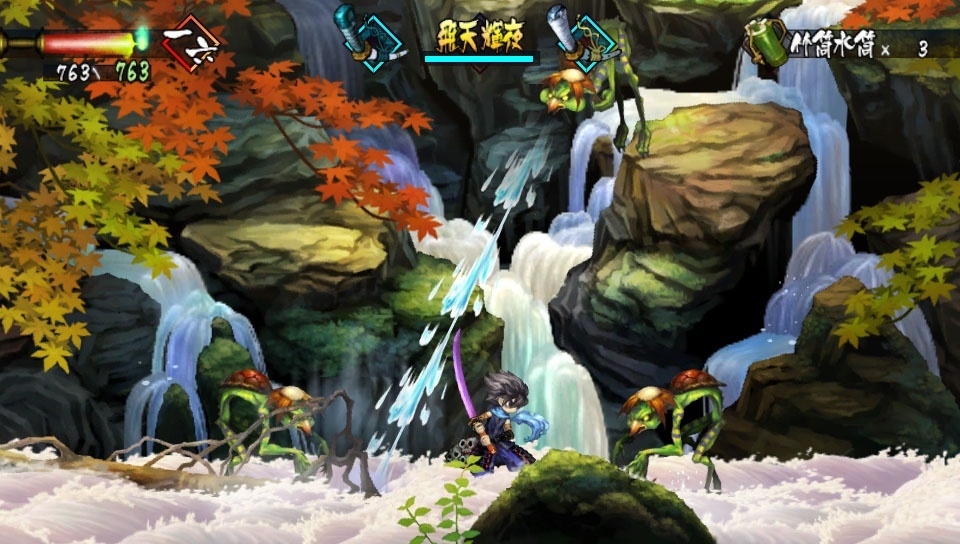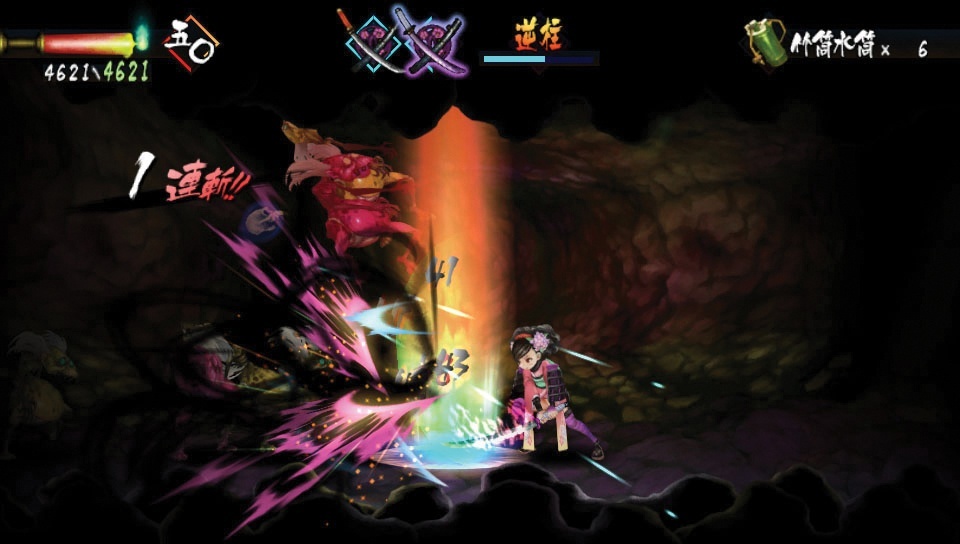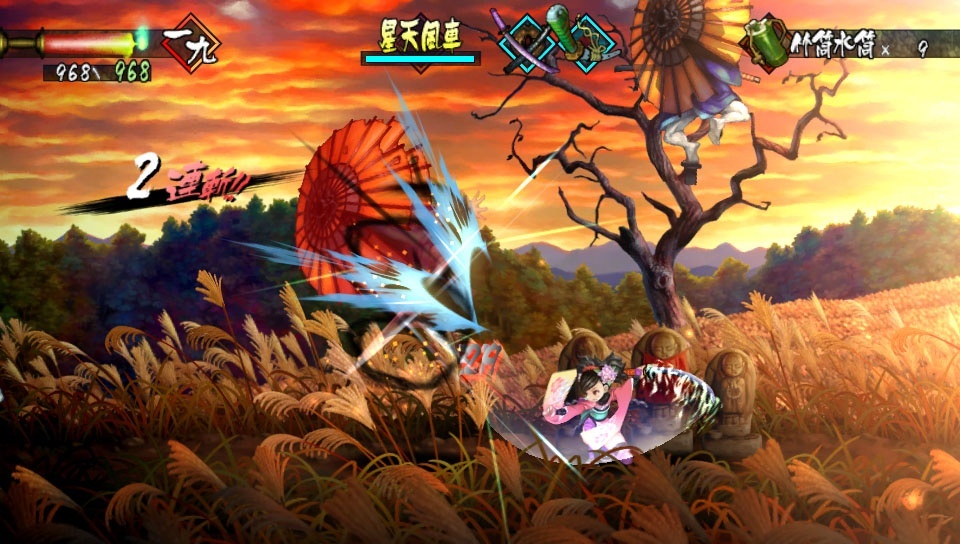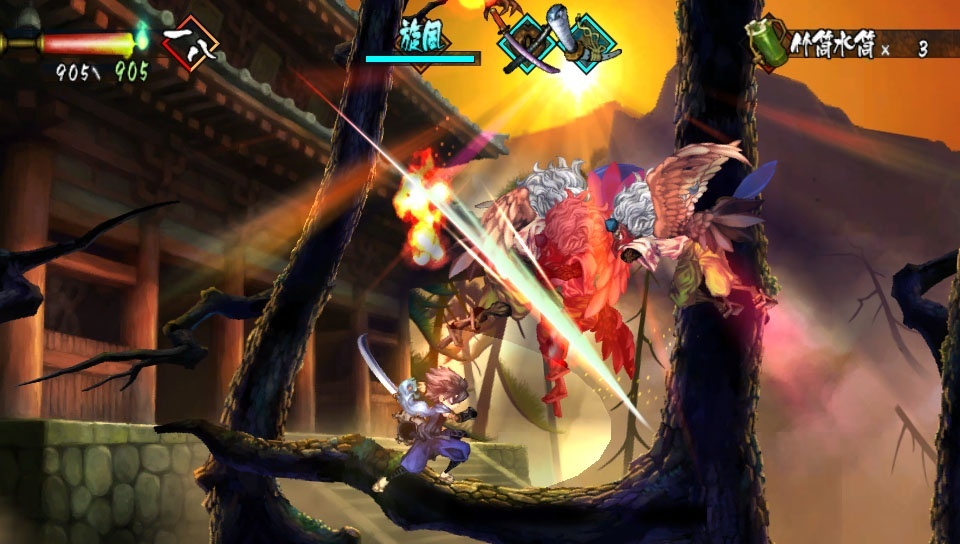Muramasa Rebirth (PS Vita) Review
By Renan Fontes  15.06.2016
15.06.2016

Released in 2009 on the Nintendo Wii, Muramasa: The Demon Blade was the third Vanillaware-developed game to be released overseas. Following the critical success of Odin Sphere, the side-scrolling action RPG had a lot of living up to do. Its release was met with less love than its predecessor's, with the biggest complaints being its limited controls and weak story. Seeking to rectify the original's mistakes, 2013 saw a rerelease on the PS Vita. Does the retelling finally manage to live up to the developer's high standards, or does it remain an underwhelming, albeit good follow-up to an amazing game?
Muramasa Rebirth offers two difficulty modes starting out: Legend and Chaos. At first glance, and on a very basic level, Legend and Chaos are simply flashy names for normal and hard. Once examined in depth, however, the two modes stand as much more than simple difficulty modifiers; they fundamentally change how the game is played. Legend offers less aggressive enemies all around, which means the output for skill is lower, making the adventure in rural Japan play like a fast-paced arcade beat 'em up. Advanced tactics aren't necessary outside of a few boss fights. It's a relaxing mode meant for immersion and fast progress.

Chaos, on the other hand, incites a bloodlust in every enemy. Encounters shoot up to be as hard, if not harder, than Legend's boss fights. Chaos requires fast thinking and every single tactic available to survive. Dodging becomes a must, and neglecting to chain combos leads to very quick deaths. On the Wii version, the Wii Remote and Nunchuk made for sloppy play. Chaos was still beatable, but fumbling and dying due to a mistake was a common endeavour. Rebirth offers the option of mapping controls fully, meaning advanced tactics can be used more comfortably. Dodging and jumping are the biggest assets for surviving, but on the Wii version, they were both mapped to the analogue stick. Rebirth fixes this up by defaulting the jump to the X button and allowing every button to have its own distinct, customizable feature.
Outside of button mapping, Rebirth's combat is 1:1 to the original. The player characters, Momohime and Kisuke, move on a 2D plane. It's very Metroidvania-esque in practice, with roadblocks ensuring sequence breaking never happens, but instead of gaining new abilities to traverse previously blocked off areas, bosses award swords that can bypass their corresponding barrier. The lack of new abilities means that Muramasa Rebirth's game feel is the exact same at the end of the game as it is at the start, which isn't altogether a bad thing. By never changing up the gameplay with a triple jump or a crawl of sorts, the combat never stops being entirely skill-based. There are no handicaps waiting to make things a bit easier, nor are there new unlockable techniques that'll make the two samurai unstoppable killing machines. Instead, how well they fare in battle relies entirely on pure, raw skill and talent.

The core combat revolves around alternating between three katanas at any given moment. Each sword has its own "spirit meter", which dictates how many times the sword can be hit before it breaks and how many times its special skill can be used. Along with having their own unique skills that change up the flow of battle, each katana falls into one of two categories: sword and long sword. Swords have shorter range, but have fast attacks and can chain combos with ease, while long swords have a long range that can hit multiple enemies at once for massive damage at the expense of slow movement. While Momohime and Kisuke play the same, the swords they can forge are different. Momohime's sword tree features primarily short swords, where Kisuke's features mainly long swords.
The sword trees aren't the only differences between the two characters. Thematically, each storyline offers something different. Momohime's story is one of demonic possession, following the young princess' body being hijacked by a samurai gone rogue. The new script expands upon the mythical Japan with some genuinely beautiful prose and dialogue and establishes Momohime's tale for what it is: world building. Her journey serves to establish the main themes of Rebirth: mortality, honour, and fate. While there isn't much character substance, there's a great deal of narrative and thematic presence. The appropriately titled "Pandemonium of the Oboro Blade" follows a traditional Japanese mythological structure, complete with a trip to Heaven, Hell, and a rage against the gods.

Kisuke's "Ninja Scroll of the Demon Blade," on the other hand, scales back the scope to tell a more personal story about love, remembrance, and, again, fate. Having lost his memories, all Kisuke knows is that he's a fugitive on the run, and, par for course for traditional Japanese folklore, the story quickly establishes a romantic connection that dominates the story. With a smaller scope, Kisuke's main battle is against the Shogun, telling a tale of rebellion and righteousness all while trying to chase after a love that's seemingly always out of reach.
The original Wii version's translation was very dry and effectively made the story a series of beats without much substance. While the pacing is still a bit odd due to Vanillaware's strict adherence to the Japanese style of storytelling, the new translation manages to make each event have more impact and gives every character a more definable identity and purpose. There won't be great twists and turns in either story, but what's there will be a tale set in a rich, vibrant world with beautiful writing, all while respectfully honouring Japanese culture and its storytelling.

Cubed3 Rating
Exceptional - Gold Award

Muramasa Rebirth manages to more than remedy the original's script and control problems. The new translation clears up story issues and makes it clear that the fast-paced, beat-by-beat story structure is less of a mistake and simply a tasteful homage to Japanese folklore. The combat benefits greatly from the additional buttons on the Vita, and being able to map the controller leads to comfortable play sessions. Sporting beautiful HD visuals, an updated and polished translation, and a control scheme befitting an action RPG, Muramasa Rebirth stands as one of Vanillaware's finest outings and the definitive way of tackling the samurai epic.
Comments
Comments are currently disabled

 Sign In
Sign In Game Details
Game Details
 Out now
Out now  Out now
Out now  Out now
Out now  Out now
Out now  Subscribe to this topic
Subscribe to this topic Features
Features





 Top
Top

